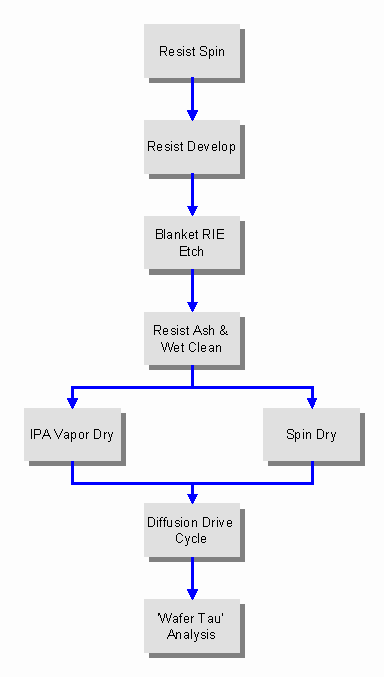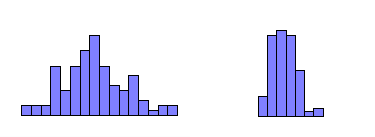
Figure 1
| ESSEX PRODUCTS INTERNATIONAL |
Detection and
Reduction of Metallic Impurities in IPA Vapor Drying
Technical Report 1104-21
Abstract:
Removal of metallic impurities on silicon wafer surfaces typically involves
conversion of the metal to it’s water soluble halide salt and rinsing the
wafer until clean. However, relatively high concentrations of metallic impurities
remain on the wafer as solutes in the DI water after the rinse step. Removal
of this water, using techniques that allow evaporation, will result in metallic
impurities redepositing on the wafer surface. Experimentation comparing standard
spin dryers to IPA Vapor Dryers has revealed that significant reduction of metallic
impurities can be realized by using Vapor Drying techniques that displace the
water with IPA before evaporation, and redeposition of metallics, can occur.
Introduction and Objectives:
Significant progress has been made in microelectronics manufacturing in
removing ionic contaminants from processing lines. Transitions in Photolithography
lines to ion-free resist and develop solutions have significantly reduced the
introduction of these contaminants into the process line. However, sensitivity
to these contaminants has also dramatically increased as device geometries,
and threshold voltages, have been reduced.
It is generally agreed that a major source of metallic impurities in the front-end of the manufacturing line is the metallic impurities inherent in the photoresist. Masking processes immediately prior to Gate Oxidation are particularly susceptible to affecting transistor threshold voltage, leakage currents, and oxide quality indicators such as breakdown voltage.
The industry has seen several significant improvements in wafer cleaning equipment designs. However the chemistry of metallic removal has remained basically unchanged. This technology relies on the conversion of metals to water soluble chloride or fluoride salts, or relies on these high-vapor pressure halides to be evaporated and removed prior to oxidation or drives in diffusion tubes.
After conversion of the metals to their water soluble halide salts, these salts must be removed in the rinse bath. Since perfect solution of the salts is not achieved, nor is perfect mixing of the rinse bath, significant concentrations of metallics are left in the water remaining on the wafer surface prior to drying.
The objective of this report is to describe the results of recent experimentation studying the effects of using IPA Vapor Dryer on metal contaminated wafers relative to standard spin drying techniques.
Experimental Method:
100 bare silicon wafers were processed according to the diagram in Figure
1 in two 50 wafer consecutive batches. The wafers were spun with ‘ion-free’
resist that contained significant amounts of metallic contaminants (Cr, Cu,
Fe, Ni, Zn). The positive resist was then developed and hardened in a RIE etch.
The resist was removed using a standard technique of plasma ashing the resist
followed with a SC2 wet clean. After the dump rinse the wafers were immediately
split (12 and 13 from each cassette) for drying. Half of the wafers were cycled
through a standard spin dryer. The other half were processed through a EPI IPA
Vapor Dryer with the Yield Enhancement, High- Throughput, and Improved Design
modifications (patents pending). See Figure 2.

Figure 1
After drying, the wafers were recombined and processed through a 1000°C Diffusion Drive cycle to diffuse the metallic contaminants into the silicon for detection and analysis.
The analysis was performed using a "Wafer Tau’ instrument manufactured by LeoGeikin in Japan. The instrument indirectly measures metallic contamination by pulsing the wafer with an infrared laser and measuring the change in reflectance of microwave energy versus time. The proportion of the reflected microwave power to the incident beam is directly related to the concentration of minority carriers in the bulk. Metallic contaminants in the bulk act as deep-level traps that increase the recombination rate of the minority carriers generated from the pulse of infrared laser light. Thus, wafers with higher metallic contamination show shorter minority carrier lifetimes.
Results and Discussion:
Figure 3 shows the results of the ‘Wafer Tau’ analysis. Spin drying
gave a mean
carrier lifetime of 180 m S while vapor drying improved performance to 310 m S.
Significant differences in both means and standard deviations were seen at the 95% confidence level.
The use of the EPI modified dryer substantially reduced the metallic contamination of the wafer. The DI water that remains on the wafer prior to the dry cycle is contaminated with soluble metallic impurities. IPA Vapor Drying allows this contaminated water to be displaced with IPA before evaporation; carrying the contaminates away from the wafer surface. Spin drying the wafer results in significant amounts of evaporation where any soluble metallic halides are redeposited on the wafer surface and driven into the wafer in the drive cycle.
Poor IPA Vapor Dryer design can also result in significant amounts of water evaporation¹ , particularly in cases of large thermal loads.

Figure 3
‘Wafer Tau’ Results Histograms (m S)
Conclusions:
Indirect determinations of metallic impurities using a ‘Wafer Tau’
analytical system have revealed significant reduction in metallic impurities
can be achieved using a EPI modified IPA Vapor Dryer as a final step in resist
removal post-cleans. This effect is most likely due to the displacement of DI
water contaminated with metallic halides from the wet clean process.
Post Script:
Information and data contained in this report has been provided to EPI by
it’s customers under various nondisclosure agreements. As always, EPI upholds
the utmost respect for customer confidentiality and has received permission
from the specific customer to reveal this information in the format shown. In
some cases the data has been normalized or similarly altered to prevent disclosure
of proprietary information. This report was compiled and edited by the EPI Engineering
Group. Any questions regarding this report should be directed to Kevin Schumacher
of Essex Products International, Inc. At the time this article was published
Kevin Schumacher was the Vice President of Operation and Engineering at S&K
Products International Inc. He is now President and owner of Essex Products
International.
References:
1. Technical Report 1102-21: "Generation and Prevention of Water Marks
in IPA Vapor Drying"